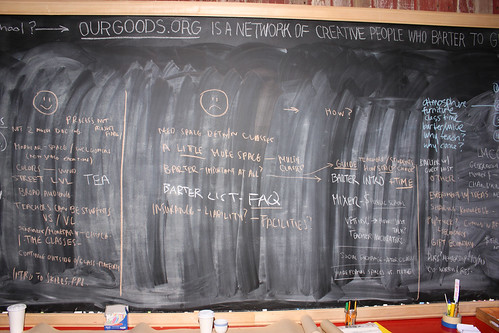I’m interested in the debate that’s been sparked by my new project. It sounds dumb but I honestly didn’t see it coming, that people who didn’t object when I published a commercial book using a certain word in the title would be so up in arms when I proposed to bring out a free, nonprofit-funded, follow-up ebook with the same word in the title. But I think it’s probably a good, necessary debate, and I’m going to let it go on without me for a bit while I carry on talking to learners and people who are making things happen in the future of higher education.
Here’s something I need to clarify, though. It’s a point I often make in presentations.
I don’t think there can be meaningful innovation in higher education or any other field if cost is not a factor in decision making. If you look at the original formulation of Moore’s Law, above, you can see plainly that “economics dictate” continuing to make computer chips smaller and faster. To put it another way, investments in technology, which can be substantial, in terms of equipment and more importantly training, have to be just that, investments with a meaningful return, or they will not be repeated. There’s a place for pure, blue-sky research but eventually you have to pick winners in order to move forward.
So, how can technology lower costs while maintaining or improving quality in higher education?
- In teaching: I point you once again to the work of The National Center for Academic Transformation. “From 1999 to 2004, NCAT worked with 30 diverse two- and four-year colleges (50,000 students annually) to prove that it is possible to improve quality and reduce cost in higher education. Course redesign using information technology is key to achieving both outcomes.”
- In administration: This is an IT no-brainer. From recruitment to retention to support services to campus energy use to supplies and logistics.
- In physical plant: Online or blended programs can reduce the need for expanding and maintaining the physical campus.
- In textbooks and course materials: Open licenses and digital distribution have the potential to radically cut costs, especially to the end user (the student), while also reducing inequity: students can have access to a wider range of higher quality material even if they are at institutions with proportionally fewer resources.
In the case of higher education, as in health care, there’s a moral reason to consider bringing down costs. The high cost of these services today severely affects our ability to provide them to those who need them, and the cost is swiftly rising. Simply dedicating more and more public and private money to these services, even if politically possible, is unsustainable. I don’t point this out because I want to impoverish, privatize, or dismantle public higher education. To the contrary, I believe the only coherent position for those who support broad access to affordable, quality public higher education in this country is to support bending the cost curve.




